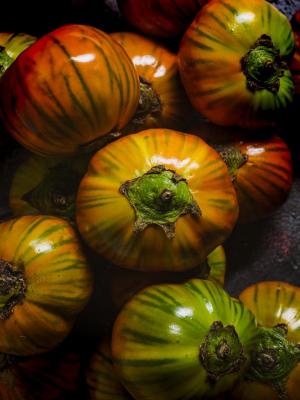Use red eggplant from Italy to make a gourmet spread
Gardens link us to our past. In my ancestors' home of Potenza, Italy, there is a town called Rotonda that every year celebrates the marriage, not of two lovers, but of two trees. It is called Sagra dell'Abete/Festival of the Fir Tree. A beech tree and a fir tree are cut from the nearby woods and taken by oxen to the main square of Rotonda, where they are hoisted one on top of the other, creating a single trunk, which is then cut with an ax.
Besides trees marrying, Rotonda has a garden vegetable unique in Europe: the Red Eggplant of Rotonda, Melanzana Rossa di Rotonda.
This bright cherry-red eggplant has a taste that is a blend of all favorite Italian vegetables, a mix of eggplant, peppers, and tomatoes.
In the Italian province of Potenza, it is traditionally made into gourmet caponata, a delicious spread served on crusty Italian bread. It is also used to make pickled eggplant. Traditional recipes of Potenza include frying the eggplant in olive oil along with garlic and mint. It is also delicious made into meatballs in combination with sausage. Red Eggplant of Rotonda can also be used to make traditional eggplant Parmesan or brushed with olive oil and grilled over charcoals.
The fruit is a round, brilliant orange-red color, and it was first brought to Rotonda, Italy, from Ethiopia right before World War II. Unlike many other eggplants, it doesn't darken when cut, so it makes attractive raw slices. Because of its red color, this is sometimes referred to as a devilish fruit. Indeed, the Italian name for eggplant, "melanzana," comes from the phrase “mela insana," meaning crazy or unhealthy apple.
Seeds are available from Baker Creek Seeds (www.rareseeds.com) and other specialty sellers.
Start Melanzana Rossa di Rotonda (Solanum melongena) seeds indoors under bright lights 8-12 weeks before your last frost date. You can also direct seed these eggplants in the garden after all danger of frost has passed and the ground is heated up. Plant the seeds 1/4 inch deep, about 2 feet apart in rows 3 feet apart. Choose a spot in the garden that gets plenty of direct sunlight.
Eggplant grows best in rich, well-drained soil, so you may want to improve your soil by digging in several inches of aged manure or compost. Keep the soil moist but not soggy. Feed the plants regularly with a slow-release organic fertilizer. Once your plants reach 6 inches high, apply a layer of organic mulch, such as chopped leaves or straw.
Since Melanzana Rossa di Rotonda can taste sharp with a slightly bitter aftertaste, it is often picked slightly unripe, while it’s still orange with green streaks.
You can save your own seeds for next year. Let the eggplants you want to save seeds from get slightly overripe, showing signs of browning. Scoop the seeds out and wash them under cool running water to remove any pulp. Spread the seeds out on a paper plate in the sun for quick drying
It is important that you completely dry out eggplant seeds the same day, or they might start germinating overnight.
So, this year plant the colorful Melanzana Rossa di Rotonda eggplant and have the most delicious caponata spread on crusty Italian bread. It is a feast fit for a wedding, even a wedding of two trees.




















































